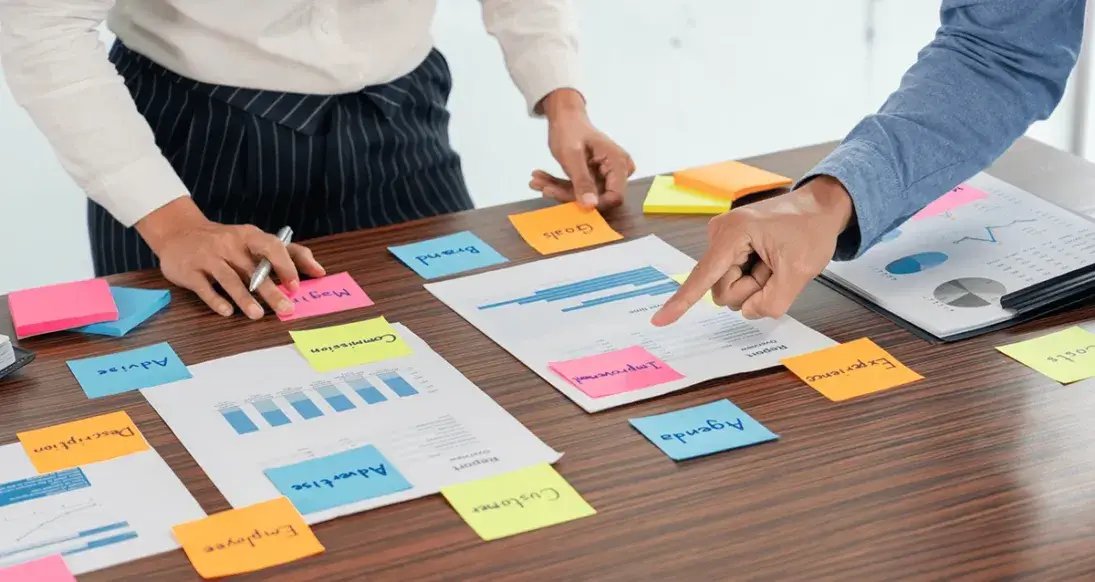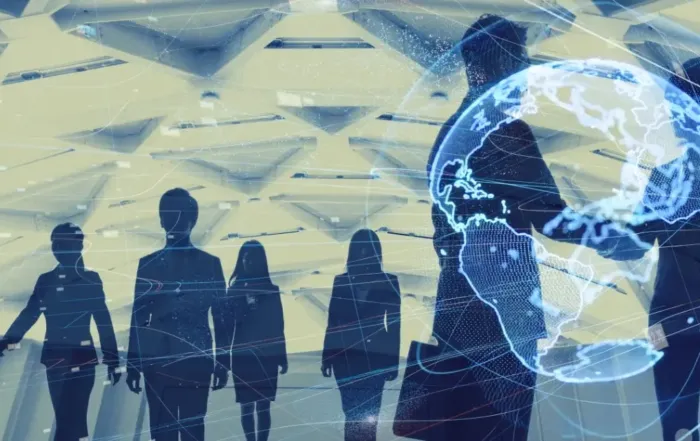Guideline for Successful Project Planning
| Translated by Julian Hammer
Project management is like a giant puzzle: many parts, methods, and requirements, all pointing to one goal — the successful conclusion of a project. In the course of your project process you have to take many decisive steps from the first project idea to the successful completion. In this process, project planning is a central phase. But what exactly is it all about? How do you create an effective plan and what should you take into account?
Economic Impact of Project Planning
The figures presented in a 2023 GPM study for projectification underline the importance of good project planning.
- “More than every third working hour is spent in projects.”
- “In terms of gross value added, this corresponds to € 1,2 billion generated in Germany through project activities.” (source: GPM)
Digitalization and Project Planning
As digitalization progresses and business processes change, project work is becoming increasingly important. Projects are increasingly organized in the form of agile task management, e.g. by means of Kanban boards. However, a good project structure is also indispensable for less complex projects. Good structures and guidelines are essential for successful project planning.
The Objective is Not a Static Project Plan
„Plans are nothing, planning is everything.“ This statement by Dwight D. Eisenhower underlines the fact that in reality plans cannot be realized one-to-one since unpredictable events can occur. Nevertheless project planning itself is of immeasurable value since they provide you with a structured approach for tackling the challenges posed by your project and serve as a guideline. A carefully thought-out plan serves as a point of reference that allows you to respond flexibly to changes, for flexibility and adaptability are just as decisive as the initial plan. Project management is not about sticking to a static plan but calls for the ability to react to unexpected developments and adjust the course of the project.
Project Planning in Practice
Project Planning is at the core of project management and can be divided into various phases:
- Initiation
- Definition
- Planning
- Controlling
- Conclusion
Good project planning lays the foundation for the successful implementation of a project. This includes the creation of a schedule, the definition of tasks, costs, and resources, as well as the definition of clear objectives and the identification and evaluation of risks in good time.
Here, effective project management methods play a significant role. They offer proven tools and techniques for managing and monitoring projects efficiently. By using these methods, project managers can minimize risks, make optimal use of resources and improve the overall quality of the project result.
 |
Beginning of Project Planning
Project planning often starts with a kick-off meeting. Here, project managers and team come together, sometimes with the involvement of external consultants and interest groups.
Templates for Recurring Project Plans
For recurring projects and tasks, solid planning is particularly important. Many companies attach great importance to a standardized project process. Project planning tools offer default templates and good tools allow you to integrate individual templates. Ongoing enhancements (lessons learned at project conclusion) help to keep optimizing these templates.
Good Processes — Better Projects
Read our case study on how a standardized project process helped Yamaichi Electronics to handle their projects professionally.
The 4 Steps of Project Planning
In practice, project planning can generally be divided into four steps which can further be subdivided into numerous individual steps or so-called processes:
1) Clarification of Project Organization
In this first step, the basic project organization is defined. The roles within the project are defined: from project management via project team up to the steering board. The project is prepared and adjustments for the implementation of the project are undertaken.
This includes the organization of the project process, the planning of all framework conditions such as costs, deadlines and personnel issues as well as the definition of the project objective. Clear, measurable, and achievable objectives are at the core of any project planning and allow you to make sure that all persons involved have the same expectations. A clearly defined objective should always be measurable, achievable, relevant, and time-bound – known in project management as SMART objectives.
Plan Risks and Opportunities of a Project

Smart Objectives
Project objectives should be SMART — specific, measurable, achievable, relevant, and time-bound. Examples for SMART objectives in different areas like product launch, process optimization, increase in sales, quality improvement, and customer loyalty illustrate the application of objectives in project planning.
Examples for Project Objectives
- Product Implementation
- Objective: Launch of a new product on the market.
- SMART Objective: “Launch of the new product by June 30 with an expected turnover of € 100.000 in the first quarter.” - Process optimization
- Objective: Improvement of internal workflows.
- SMART Objective: “Reduction of processing time by 15% by the end of the year and implementation of a new workflow management system.” - Increase in sales
- Objective: Increase in sales.
- SMART Objective: “Increase in sales by 25% within the next six months by implementing a targeted marketing campaign.” - Quality improvement
- Objective: Product quality improvement.
- SMART Objective: “Reduction of the error quota by 20% by the end of the quarter and implementation of an enhanced quality control process.” - Customer loyalty
- Objective: Improvement in customer loyalty.
- SMART Objective: “Increase in customer satisfaction by 15% within the current year by imp
2) Outline Planning
The outline planning of a project combines various steps in which the actual project structure is elaborated. The tasks and work steps to be planned are coordinated before planning effort, and hence the project timeline, in a later step. In this early planning phase, the basis for project planning is usually formed on the basis of a work breakdown structure (WBS) and all contents are interconnected.
The WBS consists of the parent project, sub-projects, and the work packages that are based on them. The WBS allows you to map the current project status, the performance progress, as well as possible problems or challenges at one glance.
Subsequently the dependencies between tasks in the project and, if necessary, dependencies between different projects are planned; in the project management software they can usually be represented by links. The main focus is on creating clarity with regard to dependencies between work packages and to support purposeful processing.
Finally a schedule is created which is closely linked to the project plan. Here, precise dates are additionally assigned to the tasks and different methods for the visualization of the schedule are used.
A common method is the establishment of a schedule in the form of a Gantt chart which maps tasks in the form of columns. The length of the column represents the duration of the respective task. This is a good way to illustrate how much effort a task entails and how it is organized over the course of the project.
Plan the Project in the Gantt Chart with Process Steps According to DIN

3) In-Depth Planning
Outline planning is followed by in-depth planning, which represents the third step of the original structure. Among other things, capacity planning (also known as resource planning) is carried out in this phase. This is part of the effort estimate and deals with the allocation of planned and available financial, time and personnel resources. Working equipment such as machines or computers are also taken into account.
Careful and anticipatory in-depth planning is of great importance since the mentioned resources have a limited availability and are possibly required for other projects at the same time which can lead to bottlenecks and overloads. This in turn would mean that tasks cannot be processed, fall behind schedule and thus jeopardize the project objective.
Furthermore the internal framework is defined to make collaboration in the project as pleasant, smooth, and efficient as possible. The descriptions of the work packages are used to define the details of the subtasks in each work package. The respective person responsible creates descriptions to make sure that everyone gets to grips with their upcoming task, even if the work package only starts several months later. In complex projects, deadlines can also be assigned to the subtasks.
Scheduling of Resources in the Project and Graphical Representation of Resource Utilization

4) Project Controlling and Project Management
Finally the focus shifts to project controlling and project management.
This includes the supervision of planning as well as the monitoring of services, resources, and hours. Projects are integrated into business activities and quality and progress are regularly reviewed.
Project controlling makes it possible to react to unexpected changes and initiate counter measures. From project start through to its conclusion, project controlling and project management are a constant factor for management and monitoring. The idea behind this is not to monitor performance as such but to ensure that the defined objectives are achieved and not jeopardized.
Controlling and Monitoring the Planned Project: Graphical Representation of Budget, Costs and Revenues

Conclusion: Project Planning as a basis for successful project management
Project planning is the core of project management and provides a basis for successful project conclusion. From the planning of individual tasks through to the allocation of resources, it maps all aspects and optimally prepares the project manager for unexpected adjustments. It equips you with the right tools that allow you to take flexible countermeasures in the case of delays and forms the basis for the kick-off meeting, ensuring that all stakeholders are on the same page when it comes to the project objective and the fundamental details of the process from the very beginning. With this careful project planning, every project becomes a complete success.
Another crucial aspect of successful project management lies in the strengths of hybrid project management. Projects are increasingly being implemented using a combination of agile and traditional methods. These hybrid approaches allow for flexible adaptation to changing requirements while maintaining the structure and control of traditional methods. Using the strengths of hybrid project management, teams can work more efficiently and further increase the success of their projects.
Whitepaper
The Most Common Mistakes in PM
13 Common Mistakes in Project Management and How to Avoid Them
Plan Projects with PLANTA
You can find more tips for your project planning in our video tutorials on Youtube
This blog post has been translated by Julian Hammer
Related Posts
RECENT POSTS
Create a Project Plan in 10 Steps — Using a Checklist
Jochen Geißer2025–07-03T07:46:33+00:0017. June 2025|
Phases of Project Management: the 5 Project Phases in Detail
Larissa Plank2025–06-16T09:14:02+00:005. June 2025|
Resource Planning in Multi-Project Management: a Guideline
Beate Schulte2025–05-22T08:18:10+00:0022. May 2025|
















